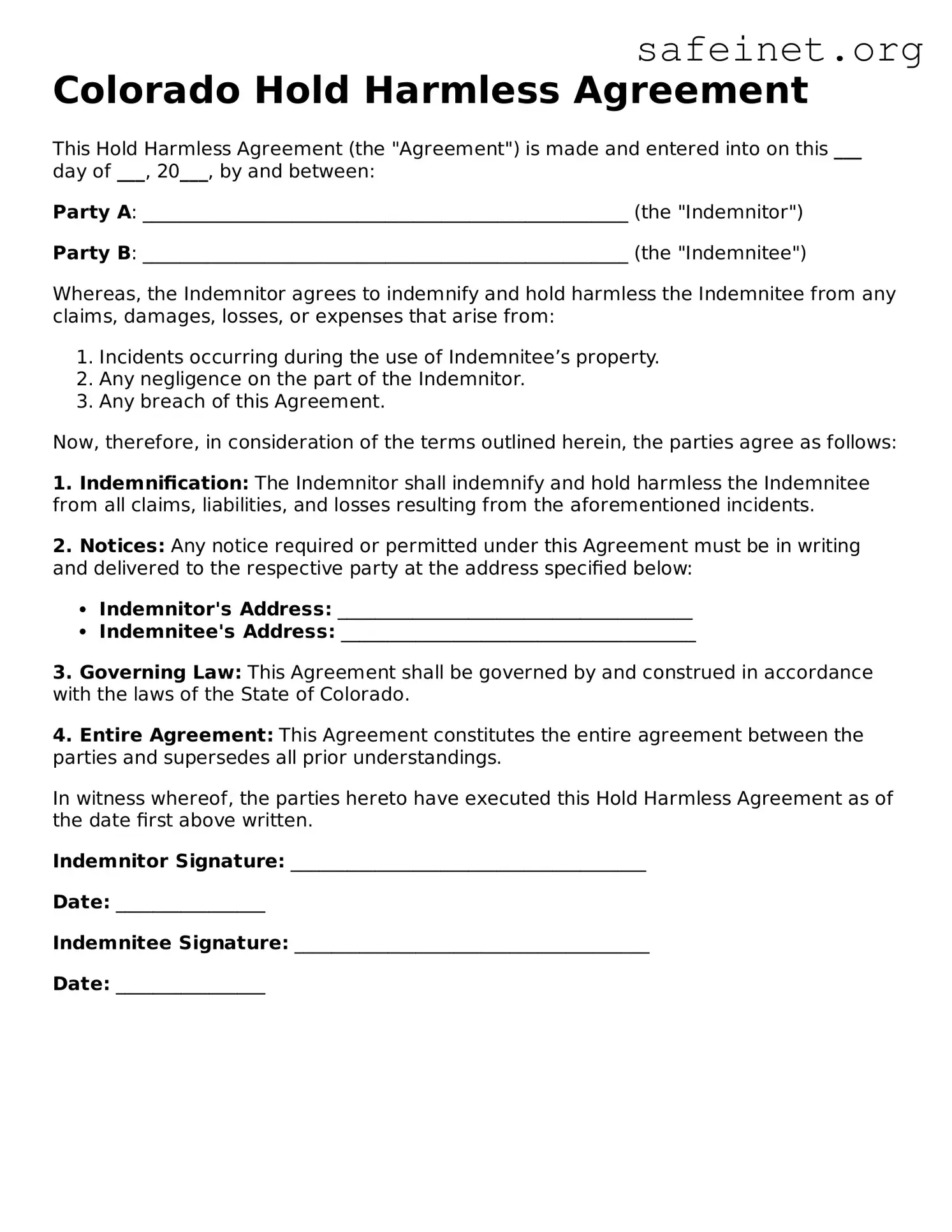What is a Colorado Hold Harmless Agreement?
A Hold Harmless Agreement is a legal document in which one party agrees to not hold another party responsible for any damages or injuries that may occur during a specified activity or event. In Colorado, this agreement often aims to protect businesses and individuals from liability claims related to activities they sponsor or facilitate.
Why would someone use a Hold Harmless Agreement?
Individuals or organizations generally use a Hold Harmless Agreement to mitigate risk. For example, event organizers may require participants to sign this document to protect themselves from liability arising from injuries that participants might sustain during the event. This is particularly common in sports, recreational activities, or community gatherings.
Who is typically involved in a Hold Harmless Agreement?
Usually, there are two parties involved: the indemnitor and the indemnitee. The indemnitor is the party that agrees to assume liability for potential damages, while the indemnitee is the party that seeks protection against liability. In many cases, the indemnitor is the participant, and the indemnitee is the organizer or facility owner.
Are Hold Harmless Agreements legally binding in Colorado?
Yes, Hold Harmless Agreements are generally considered legally binding in Colorado, provided they meet certain criteria. The agreement must be clearly worded, voluntarily signed by all parties, and it should not violate public policy or statutory regulations. Courts in Colorado tend to uphold these agreements unless they are found to be unfair or overly broad.
Can a Hold Harmless Agreement protect against negligence?
In Colorado, Hold Harmless Agreements can include provisions that protect against negligence; however, there are limitations. An agreement cannot protect a party from willful misconduct or gross negligence. If a party acts recklessly or with intentional harm, a court may not enforce the agreement for those actions.
How should a Hold Harmless Agreement be structured in Colorado?
A well-drafted Hold Harmless Agreement typically includes the following elements: a clear title indicating that it is a Hold Harmless Agreement, a description of the event or activity, the identities of the parties, the scope of the indemnification, and a statement about the voluntary nature of the signing. It is also wise to include a section addressing the governing law, which in this case would be Colorado law.
Do I need a lawyer to draft a Hold Harmless Agreement?
While it is possible to draft a Hold Harmless Agreement without legal assistance, consulting a lawyer is often advisable. Legal professionals can ensure that the agreement complies with Colorado laws and is tailored to the specific circumstances involved, thus enhancing its enforceability and protecting against potential legal challenges.
Can a minor sign a Hold Harmless Agreement?
In Colorado, a minor generally cannot legally enter into a binding contract, including a Hold Harmless Agreement. However, parents or legal guardians can sign on behalf of the minor, thereby assuming responsibility for their child's participation and acknowledging the risks involved. It is crucial to ensure that the agreement clearly states this arrangement.
What should I do if someone asks me to sign a Hold Harmless Agreement?
If someone asks you to sign a Hold Harmless Agreement, it is important to read it carefully and understand its terms. Consider the activity involved and the level of risk you may be assuming. If you have doubts or specific questions, seek clarification from the other party. Consulting with a legal professional can also help you understand your rights and obligations before signing.
